|
|
|
|
Thursday, December 28, 2023
MEMORY KEEPER: STORIES WITHIN The COLLECTION
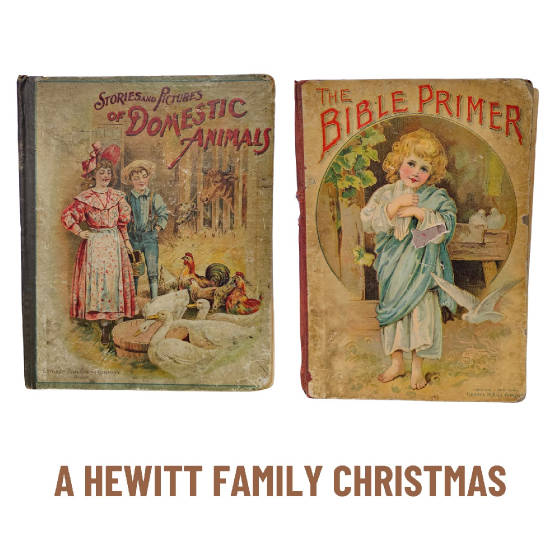
By Jamie Kramer These books belonged to Frank and Naomi Hewitt. They
were the children of John C Hewitt and Hattie Howard. Frank Hewitt was born on February 16, 1888 in Bay
City, Michigan. Naomi Hewitt was born December 15, 1897 in Ann Arbor, Michigan. Stories and Pictures of Domestic Animals is inscribed “A Merry Christmas to Fred.” The
Bible Primer is inscribed “To Naomi Hewitt…1901.” Eventually these books were in the possession of Haddie Savage of
Bay City. She gifted them to her great-grandson in the 1960s.
Burnham, Anna F. Stories and pictures of Domestic Animals. Boston, MA: D. Lothrop Co., 1879.
Bible primer. Chicago, IL: G.M. Hill Co., n.d.
Wednesday, December 20, 2023
Did you know? Nate Doan Santa House
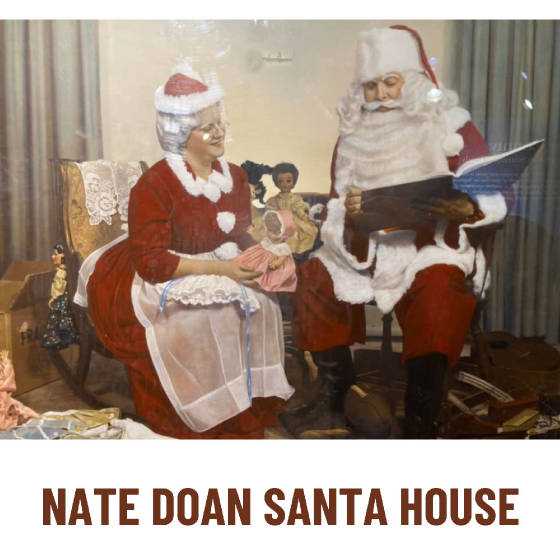
By Sam Fitzpatrick Nate Doan
Bay City legends
Nate and Mary Ida Doan were famous for the Santa House, founded in 1991. It began in 1940 when a Santa called in sick
at the Christian Assembly Church on E. Vermont Street. Nate filled in and fell in love with the job. He was busy
for a month working as Santa, which prompted Mary Ida to play Mrs. Claus so she could be with him.
 Nate and Mary Ida graduated from the Charles W. Howard Santa Claus School in Albion, NY. They were the
first couple to do so together. In 1966, the Doans took over the Santa School and moved it to Bay City in 1973.
The school consisted of a three-day course at the Christian Assembly Church in October. Would-be Santas attend it from
all over the United States, Greenland, Switzerland, and Australia. In 1990, the school's location moved to Midland. Nate and Mary Ida graduated from the Charles W. Howard Santa Claus School in Albion, NY. They were the
first couple to do so together. In 1966, the Doans took over the Santa School and moved it to Bay City in 1973.
The school consisted of a three-day course at the Christian Assembly Church in October. Would-be Santas attend it from
all over the United States, Greenland, Switzerland, and Australia. In 1990, the school's location moved to Midland.
Throughout the years, Nate Doan made numerous visits as Santa Claus to Santa Houses, hospitals, stores,
nursing homes, and schools. In 1989, he retired after a nearly 50-year career.
Santa
House
 In 1991, the original Santa House opened at the former Eastern Tourist Association (EMTA) building in Wenonah
Park at the foot of Sixth and Water Street. In 1998, the Double Tree Hotel was set for construction, which resulted
in the relocation of the house to the current location across from the Bay County Community Center. In 1991, the original Santa House opened at the former Eastern Tourist Association (EMTA) building in Wenonah
Park at the foot of Sixth and Water Street. In 1998, the Double Tree Hotel was set for construction, which resulted
in the relocation of the house to the current location across from the Bay County Community Center.
Each
year, hundreds of children wait their turn at the Santa House to visit with Mr. and Mrs. Claus and admire the various Christmas
displays inside. A favorite room is the kitchen display, where elves are baking Christmas cookies.
Doan Dedications
Nate and Mary Ida Doan were inducted into
the International Santa Claus Hall of Fame in Santa Claus, Indiana. In 1982, the City of Bay City dedicated the Nate
Doan Park on the City's west side in his name near his family home. Since Nate's passing in 1997, Mary Ida has continued
to be involved with the house.
Want to learn more about The Santa House and the Doans? Visit the
Historical Museum of Bay County to see the Nate and Mary Ida Doan Santa House exhibit! Sources: Mary
Ida Doan, 2020 Bay County Historical Society's Nate Ida Doan Exhibit
Thursday, December 14, 2023
The Battle Of The Bangs At Central High
By Gary (Dr. J) Johnson
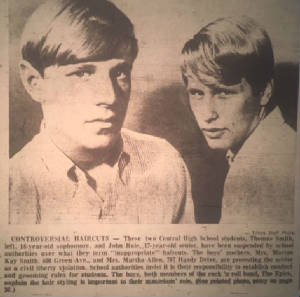
At the start of the 1965-66 school year at Bay City Central High School the rules
regulating the hair length of male students were strict. School administrators around the state believed that longer styles
would have a negative effect on learning, and the grooming directives were very specific in regard to how long a young man's
hair could be on the sides and back of his head as well as the bangs in front. When two students challenged those rules, it
set off a controversy with serious repercussions. Inspired by The Beatles, John Hale (vocals)
and Tom Smith (keyboards) started playing music together while they were students at Central High. By the start of 1965, they
had put together a band called The Epics, and they signed on with Bill Kehoe and Delta Promotions who began managing and booking
the group – most often at Kehoe's Band Canyon teen club in Bay City. Hale and Smith would become figures of controversy
during the fall of 1965, however, when the length of their hair became a disciplinary issue at school and the subject of numerous
stories in the Bay City Times. "I kind of knew Tom but we became much closer after
we started playing music together," Hale recalled. "I was just the singer at that time." The Epics' first
gigs were at school parties and dances, but after they won a Battle of the Bands competition at Daniel's Den in Saginaw, the
group earned a cash prize and engagements to play at the popular teen club. In a recent interview
John Hale picked up the story. "Our bass player got drafted and Bill Kehoe, who was managing us at the time, said to
me, 'Why don't you play bass'? When I told him that I didn't know how, he said 'You're gonna learn'; and that night he brought
a bass guitar and amp to my house. My mother, who wasn't a music teacher but was an accomplished musician who played organ
in church, sat up with me and taught me how to play the chromatic scales and I've been a bass player ever since," Hale
recalled. By the fall of 1965, The Epics had gone through a few lineup changes and now
featured Smith on keyboards, Al Hill on lead guitar, Mike McBride on drums, and Hale on both lead vocals and bass.
Guitarist Al Hill was interviewed years later by Bill Holtzapple about his years in the Epics. "John
Hale was a good front man. He was good looking and had a lot of girlfriends. He was a big attraction which is important for
any band," Hill said. "The stage clothes had that English look we were going for that was so popular during the
British Invasion years. Our song material was also British Invasion stuff mixed with original composition things – Tom
Smith was the lyricist and I put together the tunes." 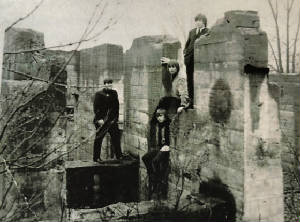 The Epics had some early publicity photos taken at the ruins of the old United Alkali Plant, a British chemical company that
was built along the banks of the Saginaw River in 1898 in South Bay City and demolished in 1928. Known locally as 'The Alkali',
the band liked the desolate look of the factory ruins, and it made for some atmospheric shots that evoked some of the bombed-out
photos of England in the years following World War II. The Epics had some early publicity photos taken at the ruins of the old United Alkali Plant, a British chemical company that
was built along the banks of the Saginaw River in 1898 in South Bay City and demolished in 1928. Known locally as 'The Alkali',
the band liked the desolate look of the factory ruins, and it made for some atmospheric shots that evoked some of the bombed-out
photos of England in the years following World War II.
The Beatles and the British Invasion
bands that followed in their wake had not only caused a musical revolution, but also a revolution in style – especially
hairstyles among young men. Many adults, including those entrusted to lead our school systems across the country, perceived
this as a threat to the established order and did their best to nip this alarming trend in the bud. In
September, just prior to the start of the 1965 school year, the Bay City Times published a long article, titled Schools Rule Styles: Good Taste Is Guideline by Margaret
Allison. It covered regulations for student attire at area high schools by stating: "Schools are ready for the fall battle
to curb far-out student fashions. Teachers, counselors, and principals are particularly bracing themselves for an invasion
of mop-headed Beatle emulators." Bay City Times published a long article, titled Schools Rule Styles: Good Taste Is Guideline by Margaret
Allison. It covered regulations for student attire at area high schools by stating: "Schools are ready for the fall battle
to curb far-out student fashions. Teachers, counselors, and principals are particularly bracing themselves for an invasion
of mop-headed Beatle emulators." According to the article, long hair and tight pants
were taboo at Bay City's high schools. 'Long hair' to school administrators meant locks touching the ears or shirt collar
and bangs longer than two fingers above the eyebrows. "If they appear this way, students will be sent home", Bay
City Central High School Principal Theodore B. Southerland informed the Bay City Times. Read
the rest of “The Battle of the Bangs at Central High” at https://michiganrockandrolllegends.com/index.php/blog/181-band-canyon-battle-of-the-bangs
Thursday, December 7, 2023
MEMORY KEEPER: STORIES WITHIN The COLLECTION
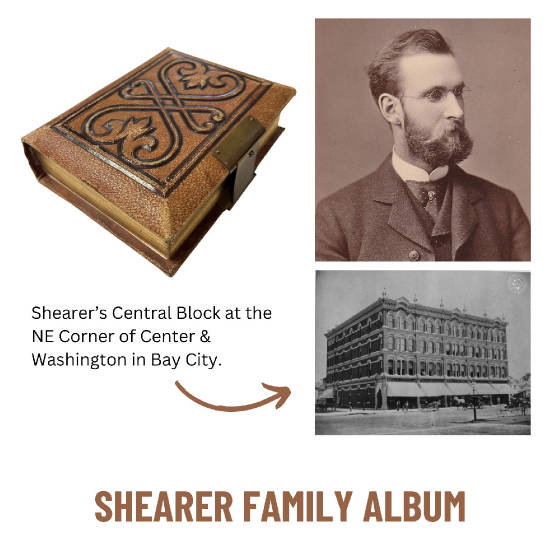
Shearer Family Album by Jill Pfeiffer James Shearer was known
in Bay City as a successful businessman and architect. He was born on July 12, 1823, in Albany, New York
and was largely self-educated. He moved to Detroit in 1838 and apprenticed in the building trade for 6-years.
He spent his evenings studying architecture and geometry. In 1844, he furthered his informal studies
by attending the Albany Academy. Upon graduation, he traveled the country working in construction and was
hired as the Superintendent of the Montgomery, Alabama State Capitol project. In 1848, Shearer returned
to Detroit to build his own architectural business. He quickly became known for his honesty as a businessman
and the quality of his work. In 1850, he married Margaret J. Hutchison of Detroit, and the couple had four
children. In 1863, Shearer and his brother George purchased
the Raymond Sawmill in Bay City, and in 1865 he moved his family to the city. He was responsible for building
several buildings in the downtown area, including the first three-story building (located on the northeast corner of Water
St. and Center Avenue) and the first brick (located on the southeast corner of Washington and Center Avenue).
From 1867 to 1881, Shearer served as president of the First National Bank. He was civically minded
and gave back to the community by serving as President of the Board of Waterworks, as a trustee for the public libraries,
as a trustee of the First Presbyterian church, and was the first president of the Lumberman’s Association of the Saginaw
Valley. In 1871, Governor Baldwin appointed Shearer as a building commission for the State Capital.
He was elected to the board of regents of Michigan University and was a member of the semi-centennial of Michigan.
James Shearer died on October 14, 1896 at his home. Bay
City building built by James Shearer: Shearer Block - Center
and Water streets in 1865 Central Block - Center
and Washington in 1874 Shearer Bros Block - Center
and Adams 1876 Sources: Biographical History of Eminent and Self-Made Men of the State of Michigan (Cincinnati,
Ohio), 1878: 52 Bay City Times (Bay City, Michigan), “James Shearer is Dead,” October 14, 1896: 3 Bay City Times (Bay City, Michigan), “Bay Man Served
on Capital Commission in 1871,” September 17, 1989: 31
2:08 pm est
Friday, December 1, 2023
Drawing on the Past: The Art of Gary Grimshaw Takes Flight, Story of the Classic Seagull Poster
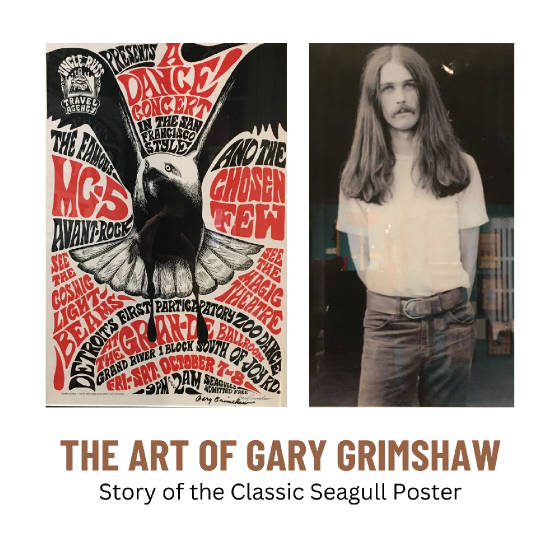
by David Hohenstein Have you seen the rock music poster
collection at BCHM? Among the stunning works on loan to the museum, many of them are by the hands of the artist Gary Grimshaw.
A Detroit Native, Grimshaw found his way as an artist in the avant garde art & music scene of the sixties and seventies,
beginning his career spanning five decades. Grimshaw’s art became synonymous with Michigan rock, jazz, & blues concerts
and festivals as well as political and community activism. He was renowned for his technical ability, creativity, talent,
imagination, and artistry. Today, as well as before his passing in 2014, he is regarded as a legend, always
remaining a true Artist of the People. Born in
Detroit, Michigan in 1946, Gary Grimshaw was twenty years old when he got the phone call that would begin his career. On the
other end of the line was the owner/promoter of one of Detroit's brand-new clubs, Russ Gibb of the Grande Ballroom. Gibb wanted
a poster to promote the opening event of the Grande Ballroom, which would be a rock concert headlined by Detroit’s legendary
MC5. Grimshaw took the job and created his first poster in one night. 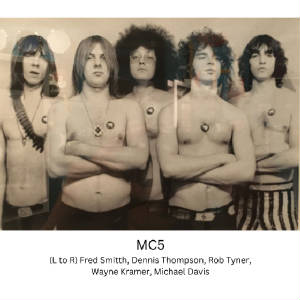 Grimshaw was intimately involved with the alternative music scene of
his city, with close ties to MC5. MC5 is now described as a proto-punk band and was made up of five members.
Noted to be one of the best rock bands of all time, they are widely known for their song “Kick Out the Jams” radical
intensity and stage performances. Grimshaw was intimately involved with the alternative music scene of
his city, with close ties to MC5. MC5 is now described as a proto-punk band and was made up of five members.
Noted to be one of the best rock bands of all time, they are widely known for their song “Kick Out the Jams” radical
intensity and stage performances.
Grimshaw had
spent some time in San Francisco, first traveling there while serving in the Navy. There he came upon their cutting-edge art
and music scene that was influencing the counterculture of his time. He went to shows and noticed the artful posters all around
the city advertising them. This certainly had an impact on the young artist, and he retained ties to San Francisco all his
life. Russ Gibb wanted a poster in the San Francisco style, and that was what Gary gave him. The copy of the poster in the museum is a 4th edition digital print c.2006 but the 1966 original would have
been a two-color separated silkscreen artwork in 1966. This piece is part of a private collection, currently on loan to the
Museum, which also includes several original Gary Grimshaw silk-screened posters. They’re all fascinating
and expertly crafted works, highlighting the many artists of jazz, blues and rock & roll that played in Ann Arbor and
Detroit. His work features the organic and lively
shapes, colors and designs that were part of the spirit of the time. The 1960’s alternative art and music scene drew
some of its influence from Art Nouveau (“new art”). These liquid, enchanting, sometimes intoxicating designs from
turn of the century Europe found a resurgence and reinterpretation in the American psychedelic rock era. Grimshaw was also
very politically minded, along with MC5 and many of the young people of his generation. The seagull art is said to
be an environmentally conscious choice, alluding to the destruction of ocean life caused by oil spills. He was also very concerned
with humanitarian issues and freedom. Poster art
& artists of the era were in a school of their own. They had access to hundreds of years of printing technology and new
means of printing and distribution were also being invented. Many artists utilized silkscreen, which was still less than 100
years old at the time. Layers of vibrant colored ink printed onto fabric or paper in the hands of artists turned a commercial
tool into an art form. Silkscreens also allow for large series of art posters to be printed in a workshop setting but are
simple enough to be accomplished in a kitchen or garage. In
addition to a two-day performance by MC5, the opening act was performed by The Wha? - also local to Detroit.
The poster advertised a performance by The Chosen Few, but they apparently chose not to show up. They had a psychedelic
light show and a “participatory zoo dance.” Sixty people showed up for the first night and
twice as many for the second. Gary became the primary poster artist at the Grande Ballroom for years with the number of images
he created for that venue alone exceeding forty-five. Gary Grimshaw, MC5 and Russ Gibb are all featured in the Michigan
Legends Rock & Roll Hall of Fame, among many other amazing artists. Sources: Grimshaw, L.E. “Gary Grimshaw: Workingman’s Artist”. GaryGrimshaw.org. 2020. https://garygrimshaw.org/bio.html The Rock Poster Society. “Gary Grimshaw.” TRPS. 2023 https://trps.org/artists/gary-grimshaw/ Erlewine, Micheal. “The Poster Style of Gary Grimshaw.” Detroit Artists Workshop. Dec. 19, 2009.
https://www.detroitartistsworkshop.com/grimshaw-gary/
|
|
 |
 |
Sign-up for the Museum's Enews! A biweekly newsletter and upcoming event notices will be sent directly to your email. Bay County Historical Society Museum
321
Washington Avenue
Bay City, MI 48708 989-893-5733
|
|



 Nate and Mary Ida graduated from the Charles W. Howard Santa Claus School in Albion, NY. They were the
first couple to do so together. In 1966, the Doans took over the Santa School and moved it to Bay City in 1973.
The school consisted of a three-day course at the Christian Assembly Church in October. Would-be Santas attend it from
all over the United States, Greenland, Switzerland, and Australia. In 1990, the school's location moved to Midland.
Nate and Mary Ida graduated from the Charles W. Howard Santa Claus School in Albion, NY. They were the
first couple to do so together. In 1966, the Doans took over the Santa School and moved it to Bay City in 1973.
The school consisted of a three-day course at the Christian Assembly Church in October. Would-be Santas attend it from
all over the United States, Greenland, Switzerland, and Australia. In 1990, the school's location moved to Midland.
 In 1991, the original Santa House opened at the former Eastern Tourist Association (EMTA) building in Wenonah
Park at the foot of Sixth and Water Street. In 1998, the Double Tree Hotel was set for construction, which resulted
in the relocation of the house to the current location across from the Bay County Community Center.
In 1991, the original Santa House opened at the former Eastern Tourist Association (EMTA) building in Wenonah
Park at the foot of Sixth and Water Street. In 1998, the Double Tree Hotel was set for construction, which resulted
in the relocation of the house to the current location across from the Bay County Community Center. 
 The Epics had some early publicity photos taken at the ruins of the old United Alkali Plant, a British chemical company that
was built along the banks of the Saginaw River in 1898 in South Bay City and demolished in 1928. Known locally as 'The Alkali',
the band liked the desolate look of the factory ruins, and it made for some atmospheric shots that evoked some of the bombed-out
photos of England in the years following World War II.
The Epics had some early publicity photos taken at the ruins of the old United Alkali Plant, a British chemical company that
was built along the banks of the Saginaw River in 1898 in South Bay City and demolished in 1928. Known locally as 'The Alkali',
the band liked the desolate look of the factory ruins, and it made for some atmospheric shots that evoked some of the bombed-out
photos of England in the years following World War II.  Bay City Times published a long article, titled Schools Rule Styles: Good Taste Is Guideline by Margaret
Allison. It covered regulations for student attire at area high schools by stating: "Schools are ready for the fall battle
to curb far-out student fashions. Teachers, counselors, and principals are particularly bracing themselves for an invasion
of mop-headed Beatle emulators."
Bay City Times published a long article, titled Schools Rule Styles: Good Taste Is Guideline by Margaret
Allison. It covered regulations for student attire at area high schools by stating: "Schools are ready for the fall battle
to curb far-out student fashions. Teachers, counselors, and principals are particularly bracing themselves for an invasion
of mop-headed Beatle emulators." 





